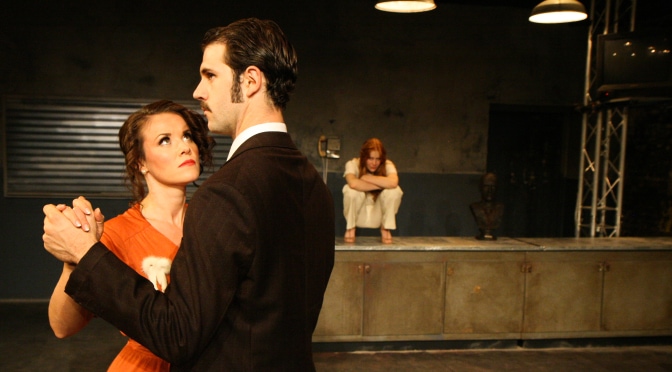Philosophy is not full of one-liners and few of those one-liners pass into general currency. Sartre’s idea that ‘hell is other people’ is now commonplace and sees dramatic exploration in Huis Clos (translated here as No Way Out). Whether you either heartily agree or dismiss Sartre’s pessimism, in either instance a night at the theatre will probably not change your mind.
Sartre presents us with three incarcerated characters who discover that their hell is to be imprisoned with one another. As the play progresses, we learn why they have been condemned. An audience will either sympathise with the characters presented or find them too contrived to be believable. Actors presenting such characters need to tread a fine line, and the cast of the Southwark Playhouse’s production manages this tension pretty well.
Although Miguel Oyarzun’s strong accent takes some getting used to, he plays Garcin, editor of a radical newspaper, with an appropriately brittle machismo. Alexis Terry’s Estelle’s desperate sexual needs are less convincing, but her confused remorse about the murder of her child is moving. The highlight is Elisa De Grey who plays lesbian Ines with great physicality. Her confusion is palpable and manic.
In all instances however, the actors are hindered by Sartre’s out-of-date sexual politics and by a directorial concept that burdens the production.
Director Luke Kernaghan attempts to broaden Sartre’s concerns by making the work more political than the author intended, and he picks up and runs with the theme of torture. From Sartre’s original idea of a bourgeois group torturing themselves in a well-appointed sitting room, we are transferred to a sterile office that surprises characters anticipating the fiery inferno. More dramatic perhaps, and certainly timely, but a great deal less subtle and pointlessly forced.
Making this concept even more contrived, Kernaghan selects the period of Argentina’s desaparecidos and adds tango to the action. Tango was banned in Argentina during the 1970s because of its potential for public gatherings, and it was also played deafeningly loudly by authorities to hide the screams of those tortured.
The surreal atmosphere and good choreography from Kele Baker means that characters bursting into dance do not provoke laughter – but they don’t add much either. A further attempt at contemporaneity also fails. With a nod to our surveillance society, video footage of the characters is played back to them. Not only does the television contradict character’s frustration that they cannot see themselves in hell, the set itself is too small for the audience to see either.
This final shortcoming is surprising when so much thought about the venue has obviously been given. The Southwark Playhouse’s relatively new home may not actually be underground but it feels subterranean. Pictures of ‘the disappeared’ line the entrance and even the bar is designed to take us back to the 1970s.
During the production, apparently random noises from the trains overhead, which could be frustrating, add to the atmosphere. Unfortunately, the context that has been forced upon the play fails to hold the attention. Rather than questioning whether hell really is other people, the trains made me think about the hell of commuting.
Until 12 September 2009
Photo by Marc Antoni Cifre
Written 23 August 2009 for The London Magazine

